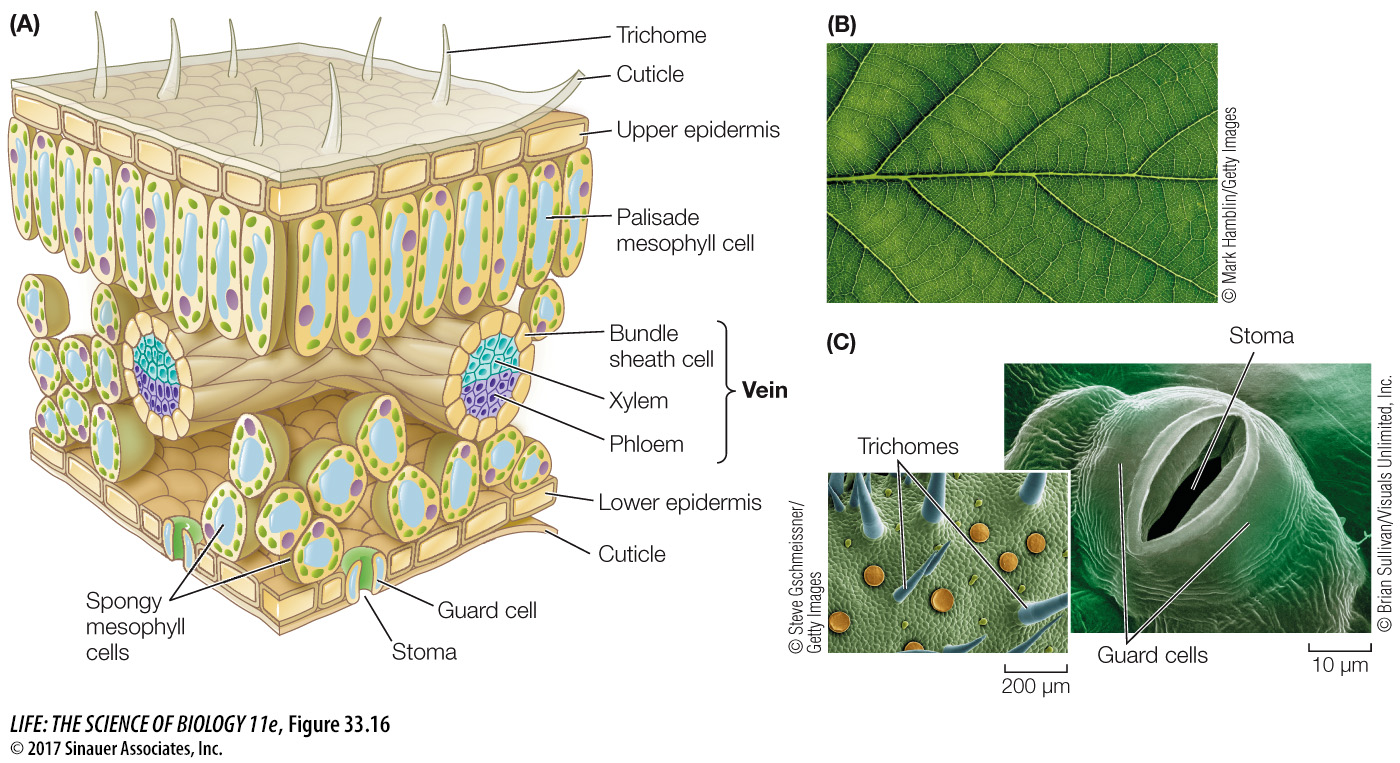Leaves are determinate organs produced by shoot apical meristems
For most of its life, a plant produces leaves from apical meristems. Leaves originate from the edges of the apical meristem as initial cells that differentiate into leaf primordia. Leaves differ from stems in two important ways:
Unlike the growth of the stem, which is indeterminate, the growth of a leaf is determinate.
Whereas the tissues of the stem are arranged in a radial pattern, the *leaf, as a flat organ, has a distinct top side and bottom side.
*connect the concepts The leaf is elegantly structured for the reactions of photosynthesis. For more detail on photosynthesis and the role of leaf tissues, see Key Concepts 10.1 and 10.4.
Leaf anatomy is beautifully adapted to carry out photosynthesis, and to support that process by exchanging the gases O2 and CO2 with the environment, while at the same time limiting evaporative water loss (Figure 33.16). Its extensive vascular system supplies the leaf with water and mineral nutrients and exports the products of photosynthesis to the rest of the plant. Figure 33.16A shows a typical eudicot leaf in three dimensions. The photosynthetic parenchyma tissue in leaves is the mesophyll (which means “middle of the leaf”). Most eudicot leaves have two zones of mesophyll: an upper layer of elongated cells called the palisade mesophyll, and a lower layer of irregularly shaped cells called the spongy mesophyll. Within the spongy mesophyll is a great deal of air space through which CO2 can diffuse to photosynthesizing cells.

Activity 33.5 Eudicot Leaf
Vascular tissue branches extensively throughout the leaf, forming a network of veins (see Figure 33.16B). Veins extend to within a few cell diameters of all the cells of the leaf by the xylem, ensuring that the mesophyll cells are well supplied with water and minerals. The products of photosynthesis are loaded into the veins for export to the rest of the plant. In addition to photosynthetic products, leaves make defensive molecules such as those you learned about in the opening investigation that produce cyanide in cassava. Investigating Life: Understanding the Synthesis and Transport of Cyanogenic Glycosides describes how it was determined that leaves produce these chemicals.
The epidermis covers the entire surface of the leaf. The epidermal cells secrete a waxy cuticle that is impermeable to water. Although this impermeability prevents excessive water loss, it also poses a problem: while the epidermis keeps water in the leaf, it also keeps out CO2—the other raw material of photosynthesis.
The problem of balancing water retention and carbon dioxide availability is solved by guard cells, a system we'll examine in detail (Key Concept 34.3). Stomatal guard cells are modified epidermal cells that can change their shape, thereby opening or closing pores called stomata (singular stoma). The stomata serve as passageways between the environment and the leaf’s interior (see Figure 33.16C). When the stomata are open, carbon dioxide can enter and oxygen can leave, but water can also be lost.